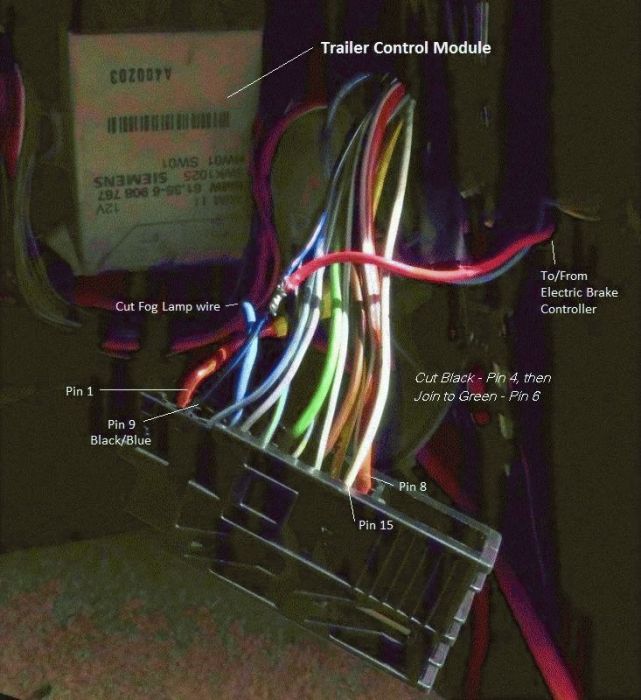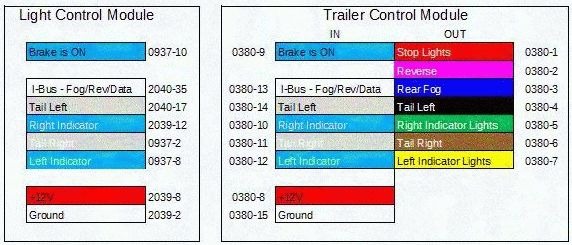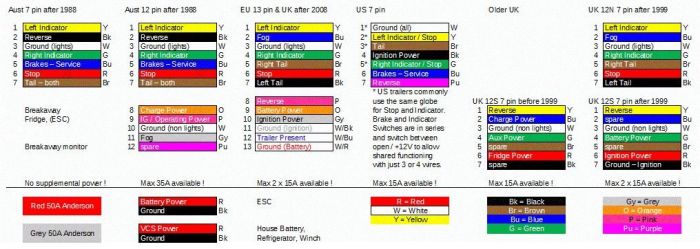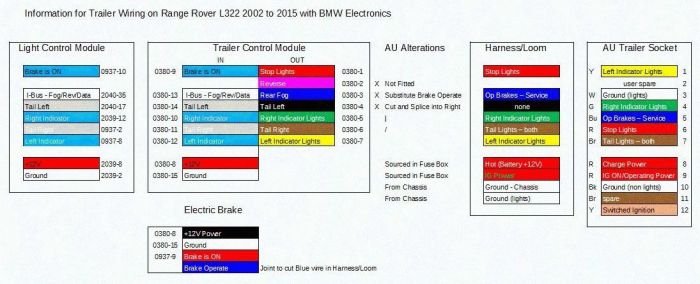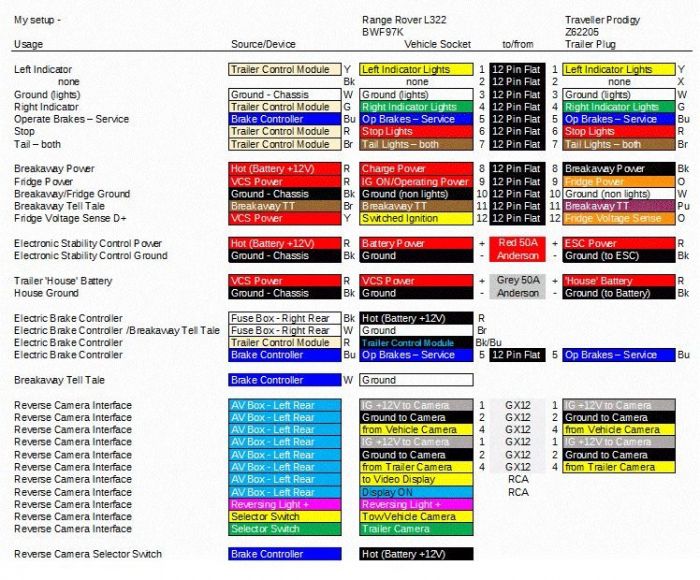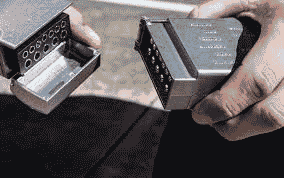 | Home > Technical (L322) > L322 Trailer Wiring - How it should be done, with pictures ! |
 
|
|
|
| bgennette Member Since: 13 Jan 2013 Location: Newcastle Posts: 88  
|
The TCM has 5 direct inputs from the LCM. Four are in parallel with the L322 rear lights - Left Tail, Left Indicator, Right Tail & Right Indicator; the Cold Test pulses on these are simply ignored by the TCM. The Brake input though is a dedicated line with only ON/OFF, no test pulses or 30% or 70% or 100% operating pulses. As the L322 Rear Fog and Reversing lights are disabled when a trailer is detected the TCM gets switch data for these functions through the I-Bus.
|
||||
|
| bgennette Member Since: 13 Jan 2013 Location: Newcastle Posts: 88  
|
Electric Brake Controllers always use the American Colours of Black = Hot Wire (+12V), White = Return Wire (0V), Red = Brakes ON input and Blue = Operate Brakes output. I mounted my controller just below the diagnostic socket on the driver's side dash fascia.
|
||||||
|
| bgennette Member Since: 13 Jan 2013 Location: Newcastle Posts: 88  
|
* Since 1988 Australia has had only one regulation for light vehicle to trailer connections which specifies just 4 types of connector; all of which have the lighting functions assigned to the same pin numbers.
|
||||
|
| Andy Member Since: 24 Feb 2009 Location: Shropshire Posts: 2951  
|
Hi. Just found this post. I have LED lights on my caravan and the brake lights flash on and off. I found another post where the black/blue wire is connected to the red wire to stop this happening. Is this what you have done above? |
||
|
| p38arover Member Since: 16 Dec 2015 Location: Western Sydney Posts: 1584 
|
Hmm, I thought Oz delivered L322 came prefitted with a towbar and wiring (according to a mechanic friend who worked at a dealer) Ron B. VK2OTC
|
||
|
| bgennette Member Since: 13 Jan 2013 Location: Newcastle Posts: 88  
|
The pre-fitted wiring assumes old style globes on the trailer and only has a 7 pin plug with fog lights wired to pin 5.
|
||
|
| Andy Member Since: 24 Feb 2009 Location: Shropshire Posts: 2951  
|
I don’t think you have 13 pin plugs in Australia so the wiring is going to be different to the plug. |
||
|
| bgennette Member Since: 13 Jan 2013 Location: Newcastle Posts: 88  
|
Australia doesn't use 13 pin EU style, nor UK N & S types, nor US opposed flat pins, we've got our own! arr, nearly.
|
||
|
| p38arover Member Since: 16 Dec 2015 Location: Western Sydney Posts: 1584 
|
Hmm, a lot of reading to do here! My L322 came with the factory fitted towbar and wiring. What was supplied in Oz was the towball mount as it's different to the UK style.
Am I reading it correctly when I assume that means trailer reversing lights will not work? Ron B. VK2OTC 2003 L322 V8 Auto 2007 Yamaha XJR1300 Previous: 1983, 1986 RRC; 1995, 1996 P38A; 1995 Disco1; 1984 V8 County 110; Series IIA |
||
|
| its me Member Since: 08 Mar 2013 Location: southampton Posts: 78  
|
I would guess that it means that the car lights will not work as it says when the trailer socket is connected. Also you would not need the reversing and fog lights work on the car,only on the trailer. 2011 4.4 tdv8 Kahn. 2007 supercharged with 2012 lights and overfinch body kit. P38 with a full J.E.Engineering conversion |
||
|
| p38arover Member Since: 16 Dec 2015 Location: Western Sydney Posts: 1584 
|
I thought the same so, after reading the workshop manual, I tried it but both the reversing lights and rear fogs still work.
|
||
|
| p38arover Member Since: 16 Dec 2015 Location: Western Sydney Posts: 1584 
|
At least the reverse light problem is solved.
|
||
|
| GraemeS Member Since: 07 Mar 2015 Location: Wagga area Posts: 2762 
|
On my RRC, I wired the rear fogs through a relay such that they were normally a set of extra stop lights. If needed for fog, they could still be switched in.
|
||
|
| p38arover Member Since: 16 Dec 2015 Location: Western Sydney Posts: 1584 
|
At the time I didn't have any diodes bigger than 1 amp. |
||
|
 
|
|
| All times are GMT + 1 Hour |
< Previous Topic | Next Topic > |
Posting Rules
|
Site Copyright © 2006-2025 Futuranet Ltd & Martin Lewis
![]()

